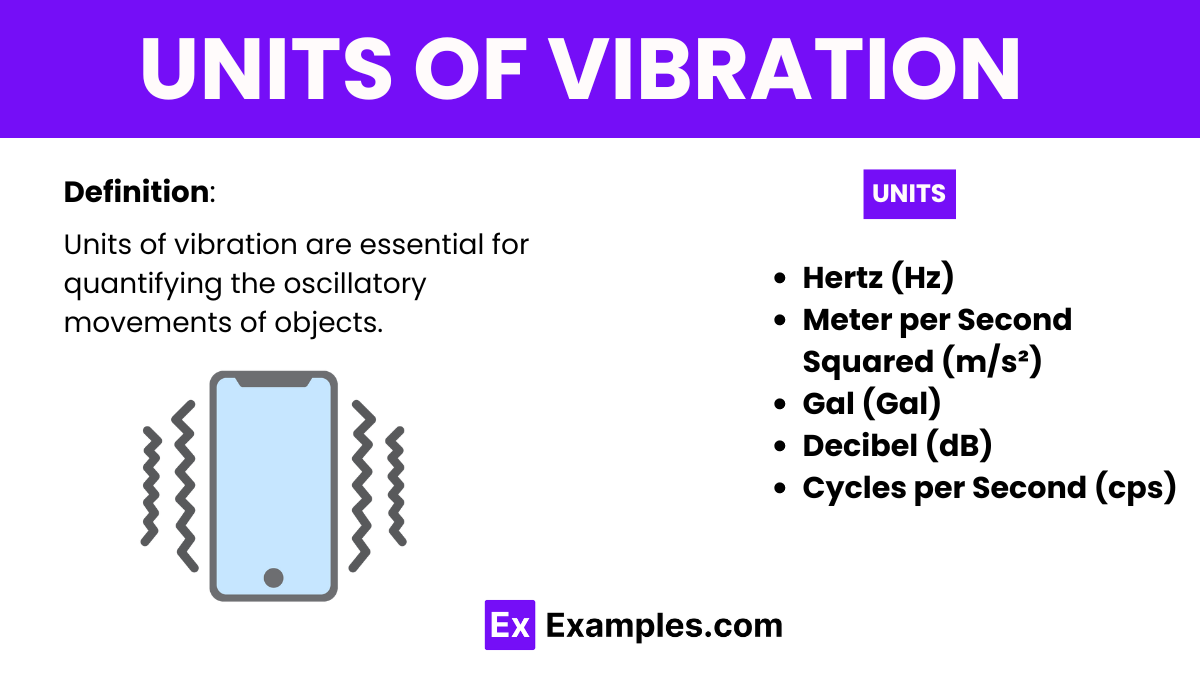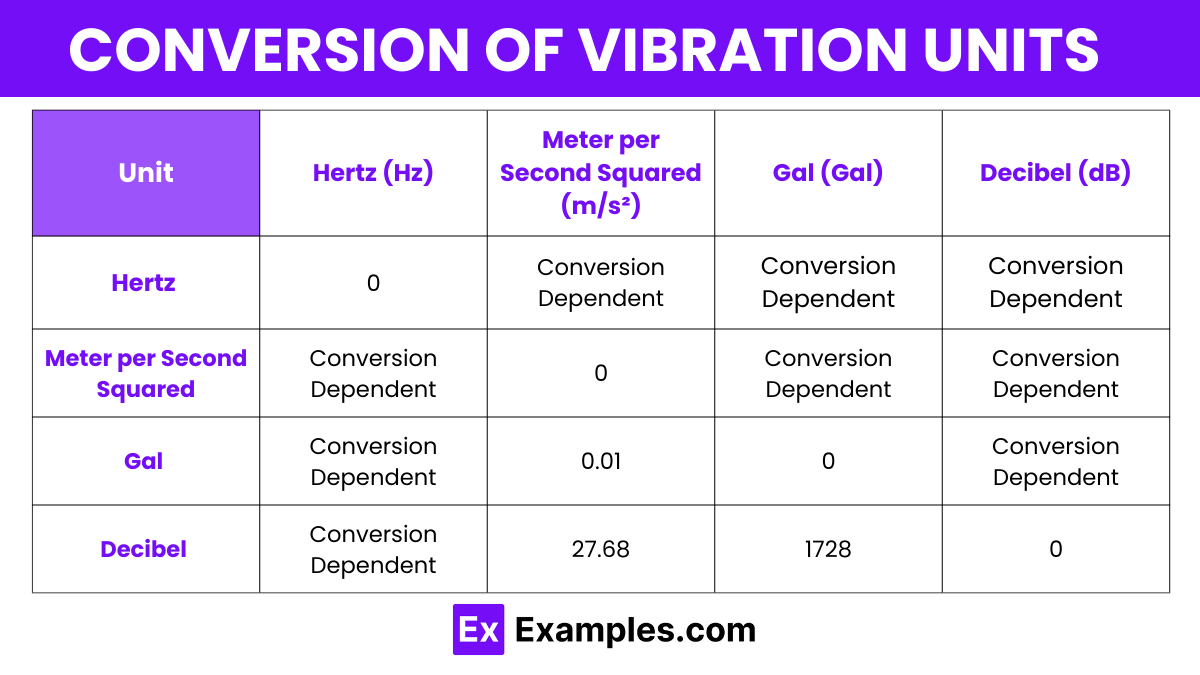What is the SI unit of frequency in the context of vibration?
Meter (m)
Hertz (Hz)
Newton (N)
Pascal (Pa)

Vibration, a physical phenomenon that involves oscillations around an equilibrium point, is quantified in various units depending on the context and the properties being measured.
The hertz (Hz) is the SI unit for measuring the frequency of vibrations. It quantifies the number of cycles a vibrating object completes in one second. Commonly used across various scientific and engineering disciplines, this unit plays a crucial role in analyzing and controlling vibrations.
Vibration, a dynamic phenomenon that occurs in various forms, can be broadly classified into several types based on how the motion is transmitted and experienced. Understanding these types helps professionals in fields such as engineering and acoustics to design better systems and mitigate unwanted vibrations.
Occurs when an object or system vibrates naturally without any external force after being initially disturbed. It continues until the energy dissipates due to damping mechanisms inherent in the system. This type of vibration is critical in understanding the natural frequencies of structures and mechanical components.
Happens when a time-varying external force is applied to a system. The resulting vibration matches the frequency of the force, not the natural frequency of the object. This knowledge is essential for designing systems that can withstand repetitive external forces, such as in automotive and aerospace applications.
In this type, the vibrations gradually decrease over time due to the presence of a damping force, which dissipates the system’s energy. Damped vibrations are particularly significant in designing buildings and vehicles that need to absorb shocks efficiently and minimize oscillation amplitudes.
Characterized by vibrations that occur at unpredictable frequencies and amplitudes. This type is commonly analyzed in environments with complex disturbances such as earthquakes or rough terrain driving. Understanding random vibrations helps in improving the reliability and durability of structures and equipment exposed to these conditions.
| Unit | Symbol |
|---|---|
| Hertz | Hz |
| Cycles per Second | cps |
| Meter per Second Squared | m/s² |
| Gal | Gal |
| Decibel | dB |
The Hertz is the SI unit of frequency, named after Heinrich Hertz. It measures the number of cycles per second that a vibrating object completes. It is universally used in physics and engineering to quantify vibrational and oscillatory frequencies.
This unit is widely used in engineering applications, particularly for measuring the acceleration due to vibrations. It represents the rate of change of velocity per second.
The Gal, named after Galileo, is a unit of acceleration commonly used in seismology to measure earthquake vibrations and other ground movements.
Decibels measure the relative loudness of sounds as perceived by the human ear. In vibration analysis, it is used to quantify the intensity level of the vibration.
Cycles per second is an older term equivalent to Hertz, indicating the frequency of cycles a vibrating object completes in one second. It was more commonly used before the adoption of the Hertz in scientific contexts.

| Vibration Unit | Hertz (Hz) | Meters per Second Squared (m/s²) | Gal (Gal) | Decibel (dB) |
|---|---|---|---|---|
| Hertz (Hz) | 0 | Conversion Dependent | Conversion Dependent | Conversion Dependent |
| Meters per Second Squared (m/s²) | Conversion Dependent | 0 | 100 | Conversion Dependent |
| Gal (Gal) | Conversion Dependent | 0.01 | 0 | Conversion Dependent |
| Decibel (dB) | Conversion Dependent | Conversion Dependent | Conversion Dependent | 0 |
Vibration is measured by sensors like accelerometers and seismometers, which quantify motion in units such as hertz (Hz) or meters per second squared (m/s²).
In vibration, dB (decibels) quantifies the intensity relative to a reference value, commonly used to measure sound and vibration levels.
Vibration value refers to the magnitude of vibration, typically expressed in terms of amplitude, frequency, and acceleration, depending on the measurement context.
Text prompt
Add Tone
10 Examples of Public speaking
20 Examples of Gas lighting
What is the SI unit of frequency in the context of vibration?
Meter (m)
Hertz (Hz)
Newton (N)
Pascal (Pa)
Which unit is commonly used to measure the amplitude of vibration?
Newton (N)
Pascal (Pa)
Meter (m)
Kilogram (kg)
What is the unit of angular frequency in vibration analysis?
Radians per second (rad/s)
Meters per second (m/s)
Hertz (Hz)
Kilograms per meter (kg/m)
Which unit is used to express the damping coefficient in vibrations?
Newtons per meter (N/m)
Newton-seconds per meter (Ns/m)
Meters per second (m/s)
Kilograms per second (kg/s)
In vibration analysis, what is the unit of stiffness or spring constant?
Newton (N)
Hertz (Hz)
Newton per meter (N/m)
Pascal (Pa)
What is the unit of displacement in the context of vibrations?
Hertz (Hz)
Newton (N)
Meter (m)
Joule (J)
Which unit is used to measure the velocity of vibration?
Meters per second (m/s)
Newton-seconds (Ns)
Hertz (Hz)
Pascals per second (Pa/s)
What unit is commonly used to measure the acceleration of vibration?
Meters per second squared (m/s²)
Newtons per meter (N/m)
Hertz (Hz)
Radians per second (rad/s)
In vibration analysis, what is the unit of force applied?
Meter (m)
Hertz (Hz)
Newton (N)
Pascal (Pa)
What is the unit of energy associated with vibrations?
Joule (J)
Newton (N)
Hertz (Hz)
Pascal (Pa)
Before you leave, take our quick quiz to enhance your learning!

